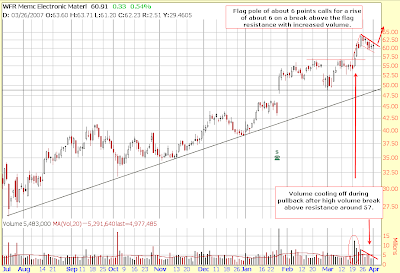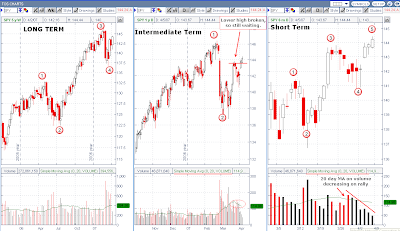Jack definitely gets the MVP award for pace setting in this group in recent months. Many thanks for setting a great example of how to trade in a disciplined way and keep it simple and consistent. Also, for sending us your info-packed emails.
The latest one with your watchlist and recommendations for our list came just before our meeting and I hadn't seen it until after we met. Sorry I've taken this long to respond to it.
Of the three stocks you specifically recommended, WFR, SIMO and DRIV, I really like WFR and would prefer to leave the others.
DRIV doesn't have an F/E score above 3.25. That's an easy place to set the bar, so let's stick to it.
SIMO looks like a stock worth following, but the volume is a bit under the 1 million level and as a result the options chain is a bit less populated than we'd like. There are only 4 months available and open interest throughout the chain could be more consistent. As a result, there are certain contracts which have a spread of .40. For example, in order to do a longer term, in-the-money call purchase, one would have to deal with a spread of .40 for the June 17.50 and .50 for September 17.50. (Again, this is after hours, so maybe it's better during the trading day.)
Regardless, the stock is up 100% in the last 8 months and it just took a hit on potentially bad news for the group. Hard not to feel like this was a momentum play that has played out.
I should note that it hasn't yet broken its recent trend or made a lower high or low yet, but the volume on the gap down is significant. I would say that until the stock breaks through the 24/25 area, it shouldn't be messed with on the long side.
(Click it to make it grow)

Now for WFR. I really like this one. Beautiful fundamental scores including very high growth rates both historical and forward looking estimates. It trades an avg. 4.8 million shares a day which results in a nice and liquid options chain. Lots of choices for months(even LEAPS) and strike prices with most of them showing quite high open interest and tight spreads. Even for those who aren't so into options trading, it's nice to at least have the option to sell covered calls or hedge a position you are in while it sits sideways or pulls back.
The only striking downside at the moment is that it is part of the semiconductors group which is looking pretty sketchy as of late. However, we can take the great relative strength of this stock to the group as a very positive sign for when the group does gain strength.
Here's the SOX on a 2 year, weekly chart. Looks very indecisive at the moment, but if I had to make a guess at which direction it would break out of the recent consolidation, I'd guess down. Wait and see.

WFR, in contrast looks like a very strong stock. I'll show the 5 year chart first to point out a bit of what we talked about at the meeting with respect to Bases as taught by Investor's Business Daily and "Proper Buy Points." The idea is to buy when it breaks out of a quality base (various structures that basically make up a period of consolidation or pulling back between resistance and support - a cup and handle, for example) with very high volume. If bought at these proper buy points, you are more likely to be able to hold a stock during mild pull backs because you have a cushion of profit to work with.
The stock has double since mid 2006, so we might be nervous about jumping in here. But the picture looks a bit different when we realize that the low in 2006 was a very healthy pullback after a gain of about 550% between late 2004 and early 2006. The most optimal recent buy point was the breakout during the week of January 22 or even the bounce off support during the week of March 5. But that doesn't mean we can't jump on for a ride at the right time.

Looking at the daily, the recent shoot up above resistance has pulled back to form a flag. A break above flag resistance with volume would theoretically have a move of about 6 points, depending on how you draw the flag pole. I've done it from the move above the recent resistance line.

The markets have been very ambiguous lately. There seems to be a bearish tone to things, yet certain stocks like WFR are acting quite bullish. It would make sense to keep some trades alive on both sides of the fence. For a bearish idea to watch for, we can look to our recently whittled down list of strong stocks. Go figure! CTSH has taken a hit this week and I can't see any obvious news to account for the reason.
Since the stock popped above its 2005 consolidation in early 2006 it has trended very steadily upward. I thought we might be building strength to break through recent resistance, but though its support line hasn't broken yet, down looks more likely than up. The MACD and Stochastic on the weekly chart would support that view as well.

On the Daily chart we have three red arrows and a very clear double top formation. The height of the top pattern measured from resistance to support between the two peaks is about 10 pts. A break with volume below that support line would project a target of 10 pts. down to 75, which also happens to be a former support level from December. For further support of the bearish case, notice the bearish divergence between a lower high on the MACD and an equal high in price.
I would give this move about 2 months to play out and buy an extra month of time in the option. The big question is whether or not to go short on the initial breakdown or wait for a test of resistance at 85. After 5 down days in a row, I would think at least a few days of relief from the selling should be in store. (I say, "Go short," meaning either sell short stock or buy puts.) If the breakdown occurs on big volume, that will be the big signal to take the trade.
As always, buying an in-the-money option is an easier way to control your risk and maximize dollar gain in the option as the stock moves(because of the higher Delta). Buying at or out-of-the-money options is trickier because there is no intrinsic value and you are much more at the mercy of implied volatility and time decay. However, if implied volatility rises and the stock does move in your favor to pick up intrinsic value, your percentage gain will be significantly higher than with an in-the-money option.

Jack mentioned in his email and asked in the meeting about having a bear list with a minimum F/E score. I responded perhaps in a flippant way that, "you want crap fundamentals with a crap chart for an ideal bearish setup." In theory, I suppose that is true, but we also have to consider that a crap chart has perhaps already been beaten up pretty good. A great performer still near the top of a fantastic ascent will have much further to fall and therefore could be much more attractive. Becasue the stock market is a forward looking mechanism that discounts all factors, it would make sense that the chart would actually precede the breakdown of what were or are still very strong fundamentals. KBH would be a good example of that happening. So with that said, perhaps it's not a bad idea to look at fundamentally strong stocks that have bearish reversal patterns going on. But to specifically require a certain fundamental strength for bearish candidates seems a bit overboard.
Again, thanks to Jack for all your input. I hope this is helpful.














